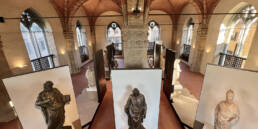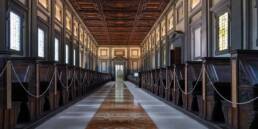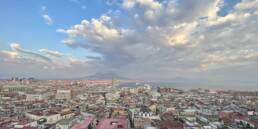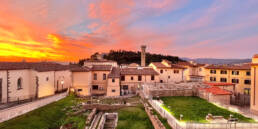La Specola Museum of Natural History has reopened this week after 400 days of closure in a much awaited event to mark the 250th anniversary of the first opening of this science museum. This museum is important because it contributes to our understanding of the history of science, in particular of how the areas of minerology, anatomy and zoology were studied in the past. What was previously displayed in an interminable series of dusty wooden cases has now been updated, with areas of the collection that were in storage for a century now out in a spectacular setting. Here’s what to expect if you visit the “new” La Specola.

The “Imperiale e Reale Museo di Fisica e Storia Naturale” opened on February 21, 1775, one of the oldest science museums to open to the public. This forms the nucleus of the collection of the museum now called La Specola, the name of which comes from the astrological observation tower commissioned by Grand Duke Pietro Leopoldo di Lorena. The zoological collection counts more than 4 million exemplars of mostly taxidermy animals, while the collection of 1400 wax anatomies, my personal favourite, similarly come from the late 18th century.
The new sections of La Specola
If you liked the old La Specola, you won’t hate the new version. You’ve still got all the benefits of the old glass cases in the second half of the museum (see below), coupled with a modern museological vision that displays some never-before-seen collections as well as highlights from the “classic” part.
The minerology collection. I have never been this excited about a rock collection. It’s all about the display. Dark, small spaces with beautiful led lighting highlight absolutely amazing samples of minerals, crystals, meteorites, worked stones, in every shape and colour, from all around the world. This was the Medici collection from the 15th to 18th centuries including some beautifully worked items that belonged to Lorenzo Il Magnifico or perhaps even his father Piero the Gouty. Many other items were collected on behalf of the Medici by Niels Stensen, father of modern minerology, apparently.

The visitor flows through small spaces. First, a hall of “minerals from space” with a really cool sound and light projection. Then a small “wunderkammer” with the most precious items. Another vast room, more brightly lit, with the greatest variety of small samples. The section ends with cases that show minerals and their application in modern society, like for computer chips.

This collection has not been on display for more than 150 years. Showing it now in this beautiful context is a modern solution to a historical collection – gone are the little numbers in a case, substituted by “from left to right” descriptions. The focus is on wowing the visitor, which it does – I overheard plenty of expressions of awe from visitors of all ages (though mostly from visitors over 70, who seem to have been agile in booking the free visits for Florentines in these first few weekdays). What would not have been bad is a QR code system should someone want to know a bit more about certain items in the collection.
The Florentine Botanical Wax Collection. This is another part of the collection that hasn’t seen the light of day of a century. There’s teaching tables of blown-up sections of plants and fruits of all sorts, realistic wax renderings, and best of all, a kind of “greenhouse” with perfect wax models of potted plants. Beautifully displayed in an immersive little room, I overheard more than one (ancient) visitor wonder how they were going to water all these plants. They are truly realistic, but they’re in glass cases with no natural light…

Adjacent to these are still life paintings by Bartolomeo Bimbi featuring exceptional fruits and vegetables donated to the Medici and quickly immortalized in oil paint (think: a huge watermelon or a deformed pumpkin, complete with a note on who donated it and where it was grown). My husband quipped: “Bimbi, better known for his invention of the Bimby” – a joke you’ll catch only if you’re Italian, as a “Bimbi” is a kind of do-everything Cuisinart called Thermomix outside of Italy that chops, heats and stirs. My mother in law says it’s for people who can’t cook…
The Art and Science section, of which the wax botanicals are part, are a new display for a small selection of the most important and perhaps least gruesome wax anatomies. This is brilliantly done with fun pink wallpaper and useful explanatory texts. The protagonist of one room is the “Venus”, a reclining female wax figure with an openable womb (currently shown closed). She’s one of my personal favourites as she’s testimony, as so many other works in this museum are, to the close link between art and science in the Early Modern Age. We think of science as objective, but the positions of anatomical figures, human and animal, are far from objective, rather personifying their gender or species according to contemporary norms. Hence the Venus wears pearls and seems to be in ecstasy at being lying in a box having her womb opened up by men.

Another room features a head and three dioramas that have been giving me nightmares since the 1990s. These are dioramas of the effects of the plague by Gaetano Giulio Zumbo. I shall leave the photos to speak for themselves.

Unfortunately, the rest of the wax anatomy collection is only open upon reservation and with a guided tour. It is possible to peek into this crowded space from the main museum path, and my thoughts are that either it’s too tight in there to accommodate many visitors, or that they prefer to have someone contextualize and explain the anatomies because they are pretty explicit.

The historical display of La Specola
Zoology. After the new rooms on the second floor, the path kind of tapers off towards the old rooms. These have been given a fresh coat of paint and the displays have been properly dusted and the glass cleaned, with an added protective coating. The display is, after all, historical, so I’m assuming the decision was to keep it grouped as is. That said, I feel like with not much expense, something could have been done to make some parts of this section a bit more exciting. In the part dedicated to underwater beings, some watery lighting and sounds. In some rooms maybe a video of the curator explaining the display, or a rendering of life for the extinct animals. Sounds, wall paint colour etc could bring the stuffed animals alive.

Here we’ve got lots and lots of mammals from around the world. I fear that not all of them met a natural death before being “stuffed” for the purpose of study some 250 years ago. The 4 million specimens, of which only a fraction are on display, are actually still important for the study of natural history, with some of the species already extinct or in danger of extinction.

In this section you’ll see everything from big cats to small birds, giant tortoises and lemurs, fish of every sort, butterflies and insects. A very few are models based on descriptions or perhaps on prints, but most of them are real preserved animals.
Is La Specola a good museum for kids?
I used to think that La Specola would be a good museum for children in Florence because of the neat animals and stuff. Looking at it today with a critical eye, I’d be careful about bringing sensitive or smaller children into this space. The minerals section would be great for kids, plenty of awe-inspiring and colourful objects in a neat display. The wax plants would also be appreciated, but to get there, you have to walk past the plague waxes and some explicit anatomies. I would avoid the wax anatomies if the child is at all impressionable, because they are made to imitate the visceral insides of humans. The large mammals and the birds would be fun for kids, though the halls are rather interminable so maybe skip a few. Teenagers may get a crack out of visiting this museum, so this might be just the key for tired teens sick of religious art. Conclusion: if bringing children under age 10, select your path of visit to avoid the “gross” parts.
What you need to know to visit La Specola
There are a few sections of this museum that have to be reserved if you want to see them. These are: The anatomical waxes complete collection; the Tribune of Galileo, a kind of lay chapel dedicated to the scientist and decorated in the 19th century; and the hall of skeletons, a 19th-century display of animal bones including some rare specimens like the Asiatic Elephant which came alive to Florence in 1655 and was exhibited under the Loggia dei Lanzi.
The museum will be open to the public regularly starting March 1st 2024. Tickets are 10 euro for adults 5 euro for kids. See the official website to book slots if you wish to see the sections that are not open as part of the regular museum path.
Sign up to receive future blog posts by email
Alexandra Korey
Alexandra Korey aka @arttrav on social media, is a Florence-based writer and digital consultant. Her blog, ArtTrav has been online since 2004.
Related Posts
January 30, 2024
Florence Museum News 2024
January 5, 2024
The Architecture of Michelangelo’s Laurentian Library
September 11, 2023
An art historian’s approach to things to do in Naples, Italy
July 19, 2023




